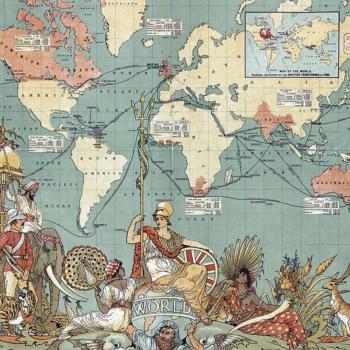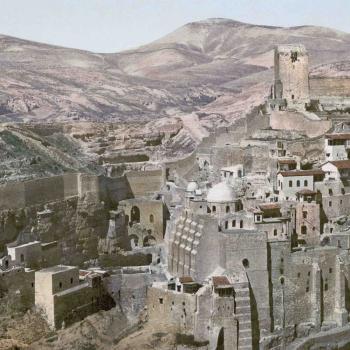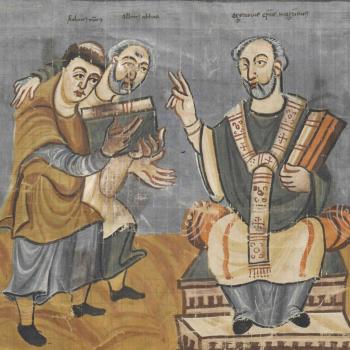Climate change, weather, and agricultural cycles all played their part in religious history. On occasion, disasters drove paranoia and persecution – see my columns on the years around 1680. My discussion of the c.1740 era suggested how a deep crisis might create an audience open to revivalism. No less fundamentally, catastrophe could decide something as basic as the world’s religious map, of where different faiths found their main centers of strength.
In my Lost History of Christianity, I wrote about the dreadful years of anti-Christian and anti-Jewish persecutions around 1320. To over-simplify a lengthy story, that coincided with a massive change in climate and the onset of the Little Ice Age. Populations had swelled during the warming period between the eleventh and thirteenth centuries. Europe’s population more than doubled during these prosperous times, forcing settlers to swarm onto marginal lands. In the late thirteenth century, however, Europe and the Middle East entered what has been described as the Little Ice Age, as pack ice grew in the oceans, and trade routes became more difficult both by land and by sea. Summers became cooler and wetter, and as harvests deteriorated, people starved. Some accounts date the crisis to a full decade, roughly 1315-25.
As another author wrote, the weather went all medieval.
Just how bad was that era? Finnish historian Timo Myllyntaus writes that
In north-central Europe and the British Isles torrential rains and floods caused a famine between 1315 and 1322 that turned out to be the severest of the medieval period. Historians regard this Great Famine as one the most catastrophic subsistence crises ever to strike northern Europe. For centuries afterward it haunted the minds of Europeans, who recalled tales of widespread starvation, violent social conflicts, tax revolts, ruthless crimes, epidemic diseases, and terribly high mortality.
In 1306 and 1323, the Baltic Sea was completely ice-bound.
I have already referred to a recent atlas mapping drought in European history. This offers a superb visual of the year 1315, with most of Europe overwhelmed by heavy rains that made farming all but impossible. Only the tip of Italy escaped.
One good book on this era is William Rosen’s The Third Horseman: Climate Change and the Great Famine of the 14th Century (2014). As a reviewer summarizes his conclusions:
With the rains, not only were crops ruined, but wood was too wet to use for fuel, which in turn made producing salt almost impossible. Salt was the period’s food preservative. Without it, every commodity that depended on salt was in turn ruined: salted herring and cod, and cheese. In addition to the rains, the weather change brought colder, longer winters, which froze the waters. The frozen oceans demolished the fishing trade. It also made wool production plummet, decimating the wool and textile trade on which much of the English and northern European economy depended. Animal epidemics added to the suffering, killing off most of the animals used for plowing, meat, milk and wool.
The world could no longer sustain the population it had gained during the boom years. Europe suffered its horrific Great Famine between 1315 and 1317, with reports of widespread cannibalism in 1318–20. Here is a contemporary English account from Johannes de Trakelowe:
The dearth began in the month of May and lasted until the feast of the nativity of the Virgin [September 8]. The summer rains were so heavy that grain could not ripen. It could hardly be gathered and used to bake bread down to the said feast day unless it was first put in vessels to dry. Around the end of autumn the dearth was mitigated in part, but toward Christmas it became as bad as before. Bread did not have its usual nourishing power and strength because the grain was not nourished by the warmth of summer sunshine. Hence those who ate it, even in large quantities, were hungry again after a little while. There can be no doubt that the poor wasted away when even the rich were constantly hungry…. Four pennies worth of coarse bread was not enough to feed a common man for one day. The usual kinds of meat, suitable for eating, were too scarce; horse meat was precious; plump dogs were stolen. And, according to many reports, men and women in many places secretly ate their own children….
Populations contracted sharply across Eurasia. Weakened populations were exposed to epidemic diseases, and the coming of the Black Death in the 1340s proved the coup de grace.
Those changes rewrote the history of religions, as terrified societies sought scapegoats, and launched persecutions on a scarcely precedented scale.
Around 1320, Middle Eastern Christians suffered a general cataclysm. Muslims targeted Christians who had long enjoyed broad tolerance. In Egypt, many Coptic churches and monasteries were destroyed, with 1321 a notoriously violent year. Meanwhile, the once-powerful Christians of Iraq/Mesopotamia were subject to brutal pogroms, and forced conversions became commonplace.
Throughout these conflicts, violence was repeatedly driven by paranoia, by suspicion of plots launched by minorities against the mainstream society. In the Middle East, that meant labeling and demonizing Christians. At one point in Egypt, Christians were blamed for setting fires across Cairo, allegedly aided by Byzantine monks armed with ingenious incendiary bombs. When some of the accused confessed under torture, the authorities were forced to support the popular movement. At one point, the sultan faced a mob some twenty thousand strong, calling for the suppression of Christians and the destruction of churches.
By midcentury, Muslim writers had access to a whole catalog of anti-Christian charges that bear close resemblance to scabrous anti- Jewish tracts like the later Protocols of the Elders of Zion. According to writers like al-Asnawi, Christians were spies ever on the lookout for opportunities to betray the Muslim cause; and cases in both Egypt and Syria proved they were serial arsonists. Given modern-day stereotypes of Islam in the West, it is ironic that Christian minorities were so feared because they were allegedly plotting terror bombings against prestigious symbols of Muslim power.
The Christian world too now became massively less tolerant, and acquired a lengthy list of demonic enemies plotting against its survival. This was indeed the era in which the great European witch persecutions began. The papacy formally listed witchcraft as a heresy—that is, as an evil alternative religion—in 1320, and women were soon being accused of the familiar package of crimes, including devil worship, poisoning, and black magic. The Irish case of Dame Alice Kyteler was one of the first of the classic witch trials. In 1320–21, southern France and Aragon suffered two outbreaks of hysterical violence, the Shepherds’ Crusade and the Lepers’ Plot. The world was changing, and definitely for the worse.
The main European victims were the Jews, who were regularly blamed for disasters of all kinds, and especially for epidemics. Pogroms and massacres surged from the 1320s. The Shepherds’ Crusade was mainly directed against Jews, and it was at this time that we hear charges of Jews and lepers conspiring to poison wells. In 1321, the King of Castile forced Jews to wear a yellow badge, and the following year the King of France ordered Jews expelled from his realm. That order was not revoked until 1359. Attacks reached new heights during the Black Death. Across Western Europe, Jewish communities were uprooted and destroyed, leading to mass migrations to the East, to lands then controlled by Poland and Lithuania.
All this, by the way, is over and above the purely secular revolts and disasters that raged in these years, such as the extensive baronial revolts against Edward II in England in 1321-22. In 1321 similarly, a civil war erupted in the Byzantine Empire.
The result of the climate-driven catastrophe was the religious world that we know in more recent times. Christians were reduced to the status of a small minority in the Islamic world, while Europe’s Jews mainly concentrated in the eastern parts of the continent – where they remained until the new massacres of the Holocaust. And Europe’s witch-panic endured for four more centuries.
Climate change destroyed one religious world and created another. Looking at the modern world, I sometimes wonder if similar changes might produce comparable consequences.
















